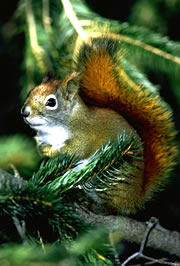Planting pushed squirrels west

Museum piece: genes show where the red squirrel went. <br>© SPL
Museum exhibits’ genes record British forestry policies
Commercial forest planting in the north of England drew red squirrels westwards in the 1980s say UK researchers. This migration led to big changes in squirrel numbers and genetics.
The finding has implications for the protection of the endangered red squirrel (Sciurus vulgaris). Many conservationists advocate leaving ’wildlife corridors’ for animals to travel between patches of fragmenting habitat. This is the first evidence that such corridors work, says Kirsten Wolff, of the University of Newcastle upon Tyne1.
Wolff and her colleagues reconstructed squirrel history by extracting DNA from museum samples dating back to 1918, and from contemporary roadkill. They compared the genetic structure of the population with satellite and historical maps of forest cover.
Deforestation in the eighteenth and nineteenth centuries left squirrels hanging on in remaining islands of trees, and competition from the larger American grey squirrel has inflicted further damage in the past hundred years. About 161,000 red squirrels remain in the UK, three-quarters of them in Scotland.
Small isolated populations are more likely than larger ones to become extinct by chance. They may also suffer from inbreeding.
Early in the twentieth century, squirrels from the northwest and northeast of England were genetically distinct, the researchers found. In the 1950s and 1960s the planting of the Kielder forest across the north of England reunited formerly isolated squirrel populations. These animals spread rapidly west when the trees reached squirrel-friendly maturity in the 1980s, says Peter Lurz, another member of the Newcastle team.
The eastern squirrels leapt westwards from one patch of forest to the next. The genetic results suggest that, although they don’t like leaving the security of the forest, squirrels can travel between habitat islands up to about 1.5 kilometres apart. This should help conservationists decide where to put nature reserves.
But joining forest fragments has drawbacks, warns Woolf: “When populations become connected, diseases can spread between them.” The deadly parapox virus, for example, is one of the biggest threats to British squirrels.
Red squirrels probably benefit more from having more living space than from the chance to mix genes, says ecologist John Gurnell of Queen Mary and Westfield College in London. Red squirrels seem quite resistant to the bad effects of inbreeding, he says – their populations have frequently crashed to small numbers.
Environmentalists have frequently opposed the planting of large numbers of alien conifers in the UK. But red squirrels depend on them, says Gurnell. “Because resources are so limited, future management will have to be highly targeted. The beneficial effects of conifers indicate a way forward for red squirrel conservation.”
Gurnell adds that conifers may also be a barrier to the grey squirrel, which prefers deciduous woodland.
References
- Hale, M. L. et al. Impact of landscape management on the genetic structure of red squirrel populations. Science, 293, 2246 – 2248, (2001).
Media Contact
More Information:
http://www.nature.com/nsu/010927/010927-3.htmlAll latest news from the category: Life Sciences and Chemistry
Articles and reports from the Life Sciences and chemistry area deal with applied and basic research into modern biology, chemistry and human medicine.
Valuable information can be found on a range of life sciences fields including bacteriology, biochemistry, bionics, bioinformatics, biophysics, biotechnology, genetics, geobotany, human biology, marine biology, microbiology, molecular biology, cellular biology, zoology, bioinorganic chemistry, microchemistry and environmental chemistry.
Newest articles

NASA: Mystery of life’s handedness deepens
The mystery of why life uses molecules with specific orientations has deepened with a NASA-funded discovery that RNA — a key molecule thought to have potentially held the instructions for…

What are the effects of historic lithium mining on water quality?
Study reveals low levels of common contaminants but high levels of other elements in waters associated with an abandoned lithium mine. Lithium ore and mining waste from a historic lithium…

Quantum-inspired design boosts efficiency of heat-to-electricity conversion
Rice engineers take unconventional route to improving thermophotovoltaic systems. Researchers at Rice University have found a new way to improve a key element of thermophotovoltaic (TPV) systems, which convert heat…



